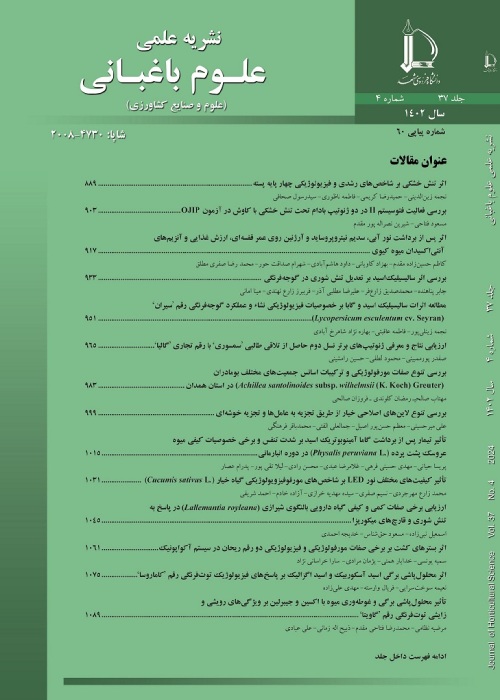Culture Optimization for In Vitro Callogenesis in Purslane (Portulaca oleracea) and Effect of Yeast Extract on Antioxidant Compounds
Purslane (P. oleracea) is considered as valuable plant due to its high antioxidant compounds and important fatty acids such as omega-3 and 6. Phenolic and flavonoid compounds are one of the most important constituents in the purslane. Phenolics are a large group of natural plant compounds with antioxidant and Anti-inflammatory properties. Flavonoids, as a subset of phenolic compounds, have a wide range of effects on plants, including antioxidant activity and improve resistance to environmental stresses. Callus culture is one of the important strategies for the production secondary metabolites, which are difficult to produce chemically. Plant growth regulators including auxins and cytokinins play a crucial role in the stages of plant growth. Various combinations of these two hormones are used to make the desired changes in the cultures. Studies suggest that the accumulation of secondary metabolites can be increased by the application of different elicitors in medium. Researchers reported an increase in the content of secondary metabolites such as phenol and flavonoid compounds in calli treated with elicitors such as yeast extract. The purpose of this study was to determine the best explant, medium and hormonal treatment for calli induction of purslane. The effect of different levels of yeast extract on total phenol and flavonoid content and antioxidant capacity of purslane calluses was also investigated.
Seeds of purslane plant were cultivated in a solid 1/2MS medium for the preparation of sterile seedlings. The explants from sterile seedlings including to leaves, 1 cm stem specimens and terminal buds, were placed on MS and 1/2MS medium containing 0, 0.1, 0.3, and 0.5 mg L-1 BAP and NAA. After five months, calluses were evaluated for callogenesis and some morphological traits such as color, texture, and size, fresh and dry weight. This experiment was conducted based on completely randomized design with three replications. In the second experiment, the calluses obtained from the previous stage were transferred to MS medium with selected hormone treatment of the first experiment (0.5 mg L-1 NAA and BAP) and different levels of yeast extract (0, 125, 250, and 500 mg L-1). Total phenol and flavonoid contents of the calluses were determined by Folin-Ciocalteau and aluminum chloride methods, respectively. Furthermore, Ferric reducing antioxidant power (FRAP) and 1,1-diphenyl-2-picrylhydrazyl (DPPH) assays were used to determine the antioxidant activities.
The results showed that 1/2MS medium was suitable for sterile seedling production from purslane seeds. Based on the present study, only stem explants in a medium containing BAP and NAA, produced durable calluses. The color of the resulting calluses were green and had a constant and firm texture. The highest callus percentage (90.46%), the size (21.6 mm), and fresh (1826.5 mg) and dry weight (75.33 mg) of calluses belong to MS medium containing 0.5 mg L-1 BAP and NAA. Results of the second experiment showed positive and significant effects of yeast extract on the total phenol, flavonoid contents and antioxidant activities. The highest content of total phenol (664.12 mg GAE 100g-1 DW), flavonoid (42.25 mg QE 100g-1 DW) and FRAP data (787 µmol Fe g-1 DW) were obtained from the calli treated with 500 mg l-1 yeast extract. The maximum DPPH IC50 (2.45 mg ml-1) was also observed in control. The formation of callus associated with plant species, hormonal composition, the stage of development, and the type of explants. Auxin and cytokinin as plant growth regulators are key factors for controlling cell division in tissue culture. In most studies, callus formation in purslane plant were induced in medium containing auxin and cytokinin. The presence of green calluses derived from purslane explants can be due to the formation of chloroplastids in the cells of the callus tissue that rapidly produce chloroplasts under light conditions. In the second experiment, increased phenolic and flavonoid compounds with yeast extract treatment probably resulted in increased antioxidant activity.
In the present study, 1/2MS medium is suitable for the production of sterile seedlings from purslane seeds. MS medium containing 0.5 mg l-1 BAP and NAA is the best treatment for calli induction from stem specimens. The concentration of 500 mg L-1 of yeast extract is introduced as the most effective concentration for increasing the phenolic and flavonoid content and antioxidant activity in the purslane calluses.
BAP , NAA , Phenol , Portulaca oleracea , Yeast Extract
- حق عضویت دریافتی صرف حمایت از نشریات عضو و نگهداری، تکمیل و توسعه مگیران میشود.
- پرداخت حق اشتراک و دانلود مقالات اجازه بازنشر آن در سایر رسانههای چاپی و دیجیتال را به کاربر نمیدهد.



